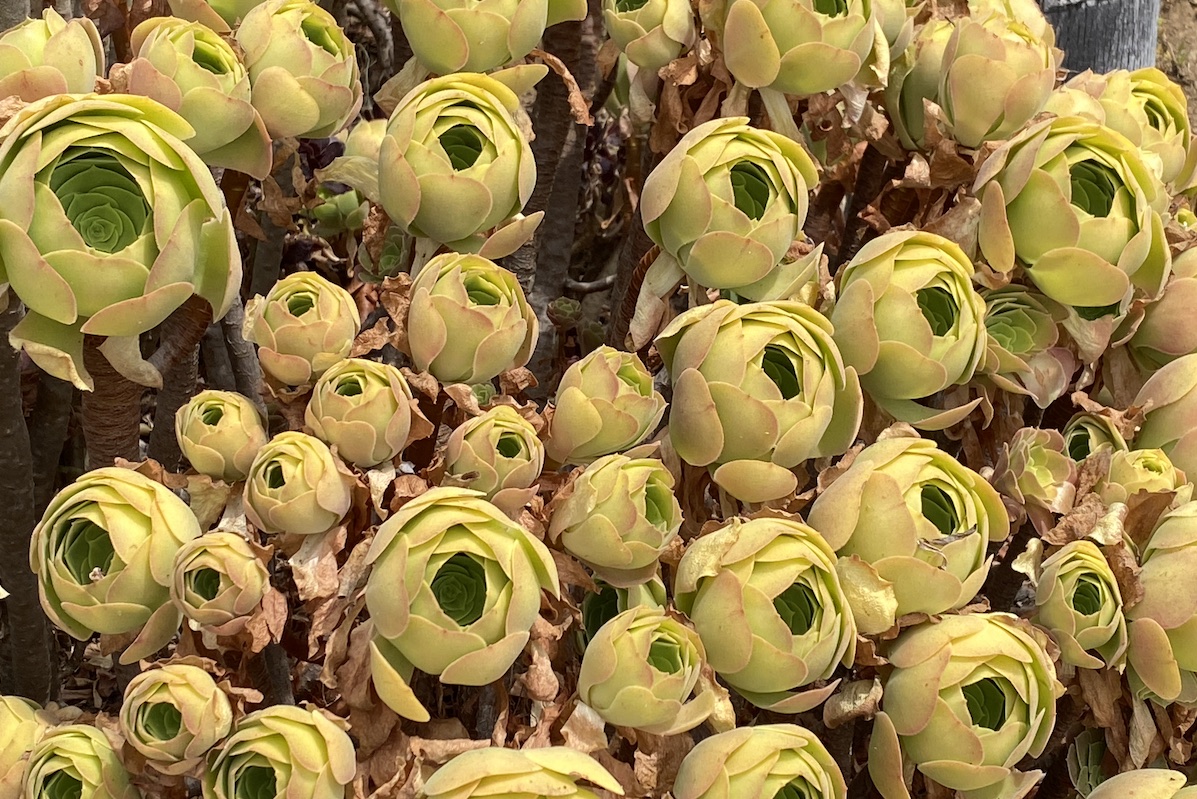
Don’t Let a Heat Wave Ruin Your Succulents
See how I evaluate my own succulents during and after heat spells in this 10-min. video.
How to Water (and Not Water) Succulents in Summer

A yucca in my garden sparkles during a late-afternoon hose-watering
After spring growth and flowering, succulents need to rest. A good way to tuck them in is to keep their roots moist. I practice these watering (and not watering) essentials in my own Southern CA garden, from around July Fourth through Labor Day.
- Pay attention to soil moisture during heat waves and desiccating winds.
- Check the automatic irrigation system. Trust me, it needs it, and maintaining it can mean life or death to prized plants.
- If the root zone goes dry, supplement auto irrigation with hose watering.
- Don't water midday. Do it early in the morning or before sunset. Watering in the heat of the day heat can literally cook roots, especially in triple-digit temps.
- A sunbaked hose contains scalding water. You probably already know that, but your house-sitter may not, so be sure to mention it. See my favorite hoses.
- Have a hose full of hot water? Aim a fine spray skyward. Droplets will cool by the time they hit leaves.

- What about aeoniums? If they're not entirely dormant, go ahead and water them. However, like dudleyas, if they've closed their rosettes, wet soil can cause roots to rot. They'll revive with winter rain.
- If the ground is concrete-hard, let a hose drip overnight to create an underground cone of moist soil.
- Trees and shrubs want water where their canopies would naturally direct rainfall: around the perimeter of the plant.
- Add crushed-rock topdressing to bare areas (or apply an organic mulch around woody shrubs) to help retain soil moisture.
- While hose-watering, take the opportunity to blast pests, fallen leaves, and dirt out of leaf axils and the centers of rosettes.
- Use a hose-end sprayer—ideally one with multiple settings—to direct water where you want it.
- Move potted succulents out of direct sun or cover with shade cloth ("floating row cover").
What about potted succulents?
Aim to keep soil about as moist as a wrung-out sponge. Once or twice a week should do it, depending on temperature and humidity. Water thoroughly to soak the soil and flush salts.
Sunburn concerns
When a heat wave follows cool weather, succulents exposed to hot sun may burn. Unfortunately here's no fixing the beige or brown patches that result from sunburn. One of the best things about succulents is also the worst: they keep their leaves for a long time. Damage may be visible for quite a while.

I propped a window screen against this west-facing window box to help a newly planted echeveria acclimate to greater sun exposure. I removed the screen a week later during a convenient stretch of cloudy weather.
Variegates tend to scorch more easily due to less protective pigment.
How to protect your plants
- Move them. Of course this is only possible if they're in pots. But don't forget to do it! Move plants out of harsh midday sun and provide more shady hours daily.
- Cover them. This is advisable for delicate, thin-leaved, in-ground succulents---in particular those you prize---and anything newly planted. Protect echeverias, kalanchoes, dainty sedums, sansevierias, sempervivums, caudiciforms, and chubby and Medusa euphorbias (among others). Use floating row cover ideally; or shade cloth, old sheets or screens. Remove as temps return to normal.

It may surprise you that the only succulent in the photo likely to sunburn is the furcraea at upper right. Its thin, variegated leaves are highly susceptible. The others---such as lampranthus ice plant, Aloe cameronii, blue senecio and firesticks---are generally not at risk except in desert climates.
High-heat succulents

A colorful Arizona garden
Succulents that can handle triple-digits without extra water (but look better with it) include cacti, jade-like crassulas, elephant's food, large aloes and agaves, beaucarneas, hesperaloes, and yuccas.
In habitat, cacti will lose delicate roots essential for taking up water when the soil goes completely dry. They live on stored moisture, then regenerate roots when the rains return.
Related Info on this site
Summer Care for Succulents: Heat and Sun Concerns
Don’t let summer sun and heat harm your succulents! Heat generally isn’t a concern. Although some succulents (like sempervivums) tend not to thrive in temps above 80 or 90 degrees F, the majority are fine. It’s heat plus sun that’s the concern.
No-Water Succulents for Southern California Gardens
Above: I based one of my most popular videos on the agave section of my bestselling book, Designing with Succulents. Both explain what you need to know to select and grow agaves successfully, and both show those best for gardens, close-up and in-ground. Some agaves are hardy to 15 degrees or less! And when small,…



Awesome information. You are my go to for help with questions before I ask. Heat spell just before another vacation, ugh! But your information gave me confidence to proceed with confidence. Thank you again, Debra.
What a day-brightener! Thank you Catherine!
You are my succulent encyclopedia. I always love your articles, photos and more. I have been a huge fan for years. My question at the moment, we sustained lots of burns on succulents (out of town☹️), should we trim them or just leave them alone. I’m so sad about all the damage we have. Thanks for all you do. Nancy
Hi Nancy — When the weather has cooled, go ahead and trim them back if they’re unsightly. Thing is, you don’t want to risk scorching healthy growth, so wait until later in Sept. Shorter days help minimize risk of sunburn, too. Depending on the variety, healthy growth will likely hide any damage and pruned areas.